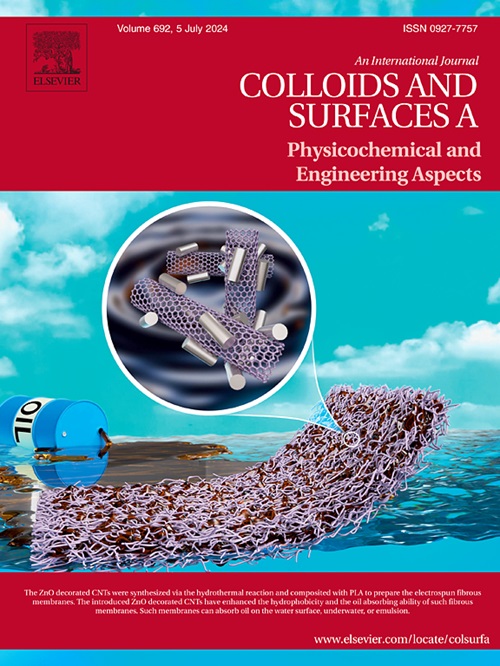对乙酰氨基酚的电化学表面增强拉曼光谱:吸附动力学和电荷转移机理
IF 4.9
2区 化学
Q2 CHEMISTRY, PHYSICAL
Colloids and Surfaces A: Physicochemical and Engineering Aspects
Pub Date : 2025-07-23
DOI:10.1016/j.colsurfa.2025.137801
引用次数: 0
摘要
电化学表面增强拉曼光谱(EC-SERS)可以详细研究金属表面的分子吸附和电荷转移。本文采用EC-SERS联合循环伏安法(CV)研究了对乙酰氨基酚(AAP)在粗铜电极上的吸附。CV证实了AAP在−1000 ~ 0 mV范围内的电化学稳定性,允许在没有氧化还原干扰的情况下进行吸附分析。AAP在8个CV循环(~ 13 min)内快速吸附,主要通过胺基相互作用形成稳定的表面配合物。反扫描时电化学电流和拉曼信号的逐渐变化表明,脱附较慢。最大的SERS增强发生在- 600 mV,此时最佳的电荷转移和分子取向最大化信号强度。密度泛函理论计算支持实验结果,证实金属分子“复合物”的形成与观测到的振动模式一致。该研究强调了应用电位对吸附/解吸动力学的影响,并展示了铜作为经济实惠的EC-SERS底物的前景。尽管与贵金属相比,铜的增强效果较低,但铜的生物相容性和表面多功能性使其适合生物医学和环境传感应用。这些见解有助于基于EC-SERS的电化学传感器在制药和生物分析领域的发展。本文章由计算机程序翻译,如有差异,请以英文原文为准。
Electrochemical Surface-Enhanced Raman Spectroscopy of acetaminophen: Adsorption dynamics and charge transfer mechanism
Electrochemical Surface-Enhanced Raman Spectroscopy (EC-SERS) enables detailed study of molecular adsorption and charge transfer at metal surfaces. This work investigates acetaminophen (AAP) adsorption on a roughened copper electrode using EC-SERS combined with cyclic voltammetry (CV). CV confirms AAP’s electrochemical stability within −1000 to 0 mV, allowing analysis of adsorption without redox interference. AAP rapidly adsorbs within eight CV cycles (∼13 min), forming stable surface complexes primarily through amine group interactions. Desorption is slower, indicated by gradual changes in electrochemical current and Raman signal during reverse scans. The highest SERS enhancement occurs at −600 mV, where optimal charge transfer and molecular orientation maximize signal intensity. Density functional theory calculations support experimental findings, confirming the formation of metal-molecule “complexes” consistent with observed vibrational modes. The study highlights the influence of applied potential on adsorption/desorption dynamics and demonstrates copper’s promise as an affordable EC-SERS substrate. Despite lower enhancement compared to noble metals, copper’s biocompatibility and surface versatility make it suitable for biomedical and environmental sensing applications. These insights contribute to the advancement of electrochemical sensors based on EC-SERS for pharmaceutical and bioanalytical uses.
求助全文
通过发布文献求助,成功后即可免费获取论文全文。
去求助
来源期刊
CiteScore
8.70
自引率
9.60%
发文量
2421
审稿时长
56 days
期刊介绍:
Colloids and Surfaces A: Physicochemical and Engineering Aspects is an international journal devoted to the science underlying applications of colloids and interfacial phenomena.
The journal aims at publishing high quality research papers featuring new materials or new insights into the role of colloid and interface science in (for example) food, energy, minerals processing, pharmaceuticals or the environment.

 求助内容:
求助内容: 应助结果提醒方式:
应助结果提醒方式:


